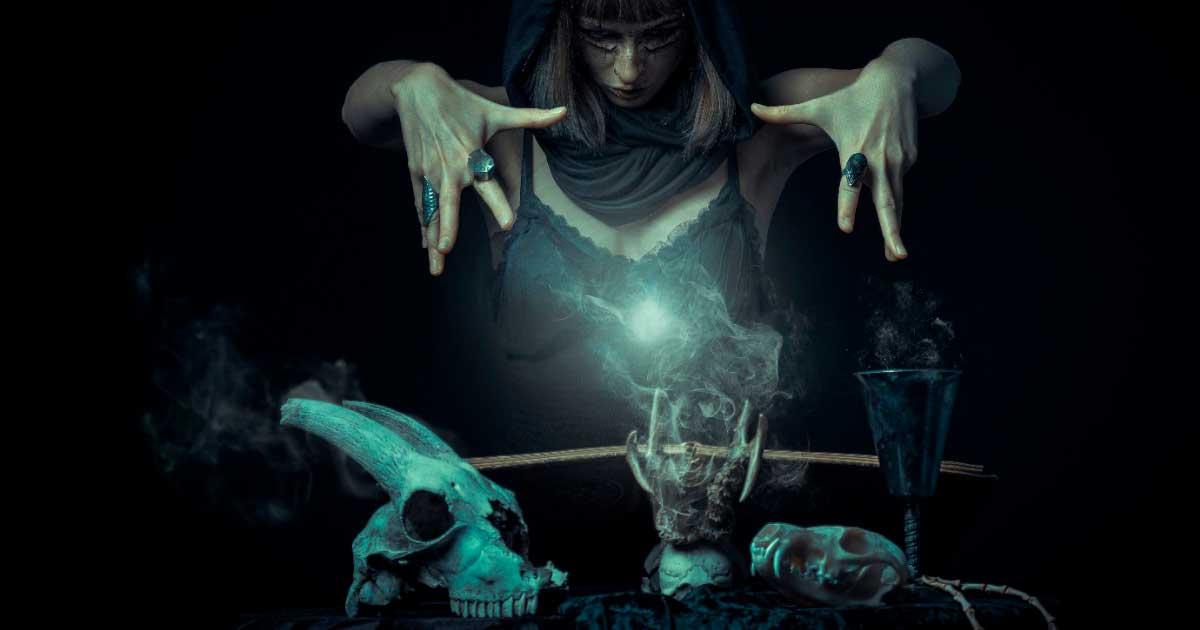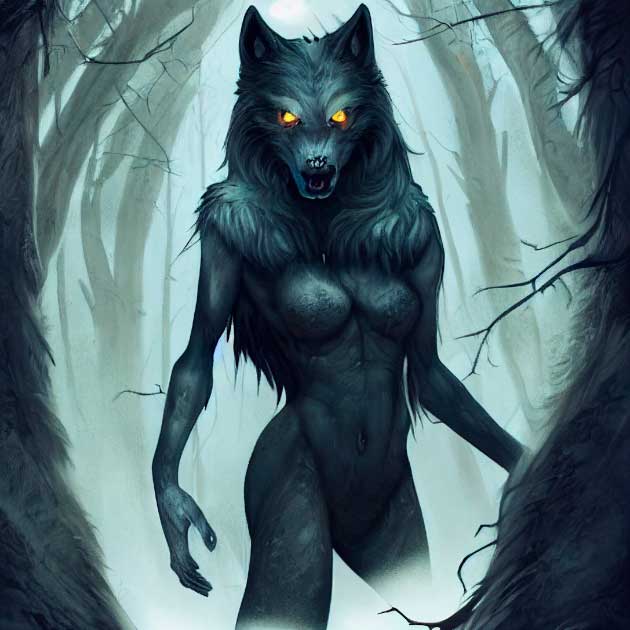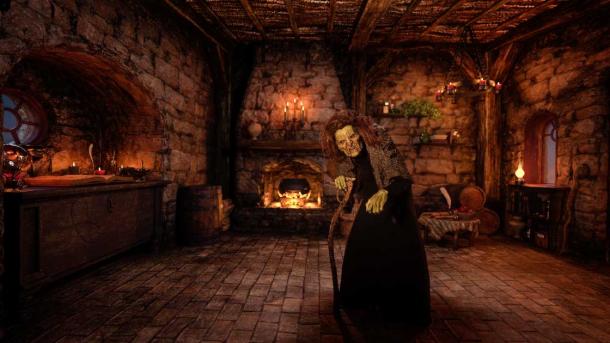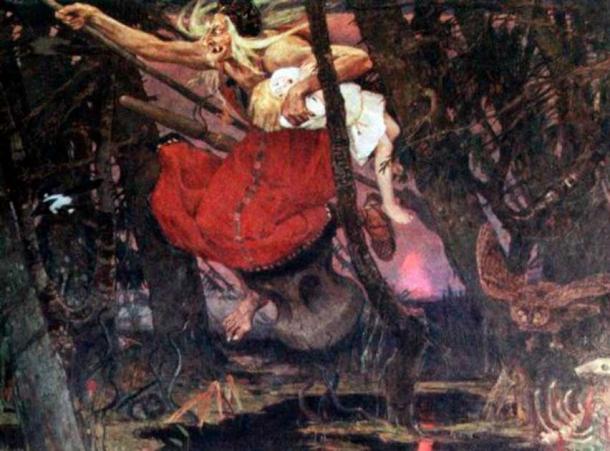
8 of History’s Most Terrifying Hags
Whether one is studying European, Asian, or American folklore, different variations of the same nightmarish creatures tend to crop up. Of all the things that go bump in the night, the most prominent is probably the hag/witch. These nightmarish, murderous, and often cannibalistic women have been cropping up in folklore for thousands of years. While some of these witches, like the Greek Circe, were always just the stuff of legend, many entries on this list were once believed to be real. In fact, in certain parts of the world, some of these hags are still feared to this very day.
1.Nelly Longarms - The Quintessential English Hag
When one imagines a wicked old hag, the first thing to come to mind likely resembles traditional depictions of Nelly Longarms. The legend of Nelly Longarms comes from Durham, England. She was described as a withered old woman with freakishly long, thin arms and wild hair.
Like many hags from European folklore, Nelly was said to have a taste for the flesh of children. She would lurk under the surface of lakes and rivers and drag passing children to their watery deaths. It was believed she would sometimes leave the water and stalk village streets making strange sounds. When she came across curious children she would attempt to lure them into nearby bodies of water.
It is believed that the folklore around Hags like Nelly comes from the old pagan gods. Nelly likely started life being worshiped as a crone, water spirit, or old god. In pre-Christian times, she likely represented wisdom, old age, and guidance. Then as times changed and Christian priests demonized the old gods she became more associated with the devilish, and morphed from an old god into a terrible monster.
- The Fate of English Witches: From Water Torture to Divine Retribution
- Witches and Pagans: Women in European Folk Religion, 700-1100 (Secret History of the Witches)
2.Circe - Homer’s Beautiful Witch
Pretty much every culture on Earth has had some form of witch/hag in their folklore, but not all of them are old and haggard. Some of them were said to be downright stunning.

Circe, the sorceress of Greek Mythology, featured in Homer's Odyssey, known for turning men into swine. (Daniel Eskridge /Adobe Stock)
The witch Circe is a prominent character in Homer’s Odyssey, the tale of the Greek hero Odysseus and his men as they attempt to sail home following the Trojan war. During his voyage home Odysseus is forced to face many obstacles, the most attractive of which is Circe.
Circe was a witch who lived on the island of Aeaea. A beautiful minor goddess, Circe had a rather peculiar hobby. She would lure passing sailors to her island with a beautiful singing voice, feed them, and then transform them into animals.
Upon landing on Aeaea, Odysseus and his men are invited by Circe up to her palace for a fabulous feast. Odysseus and a handful of men remain on the ship, but the rest accept the invitation. As they march to the palace, the sailors come across strangely docile animals who neither attack nor flee from them. Upon arriving all of them, bar a sailor named Eurylochus, fill their bellies with Circe’s amazing food. Of course, the food was dosed with one of Circe’s potions and the sailors all transform into pigs.
Eurylochus flees to warn Odysseus. With the help of the gods, Odysseus manages to trick Circe into restoring his men, and even beds her. Circe becomes somewhat of an ally and Odysseus and his men remain her guests for the next year. Upon his leaving, she guides him on where to go next so that he might reach his home, Ithaca, safely.
3.The Aswang - The Ultimate Bump in the Night
The hags of both Asian and European folklore tend to have one thing in common, a predilection for cannibalism. In Filipino folklore one of the most terrifying hags is the witch/vampire/werebeing hybrid known as the Aswang.

Weredog, one of the representations of the Aswang witch. (Alguien/Adobe Stock)
The Aswang is commonly described as a witch combined with other creatures similar to that of European folklore. Sometimes it is a straight witch, sometimes a witch/vampire. Sometimes a weredog and sometimes a viscera sucker.
Most versions of the Aswang hunt at night, stalking their prey by shape shifting between animal forms. Once the Aswang has settled on its next victim it sits atop their homes until everyone inside is soundly asleep. While it waits it uses its long, dexterous tongue to read the people in the house, much like a snake uses its tongue to test the air.
The Aswang then enters the house and depending on the version either drinks them dry, devours their viscera from the inside out, or eats them whole. The deadliest form of Aswang is a witch that through making a deal with a demon has become an Aswang. These Aswang curse the innocent by making objects like rice, bones or even insects come out of every bodily orifice.
4.Chedipe - The Foot Lover
In a lot of folklore, women are not born hags but become them by acting in ways that the culture of the time deemed inappropriate for women. Hags, historically, were a way of demonizing women and making them seem untrustworthy. The Chedipe is a really, really weird example of this.
In Indian folklore, the Chedipe is a witch-vampire hybrid that occurs when a woman dies an unnatural death, such as during childbirth or by suicide. Or sometimes just when a prostitute dies.
The Chedipe is described as a vulgar-looking woman who roams the land at night riding a tiger. She chooses a home to invade and then, completely naked, forces the door open with magic. She then casts a spell on the house’s residents, putting them all into a deep slumber. The Chedipe then begins feeding. How does she do so? By sucking the toes of the men of the house of course. Depending on the tradition the Chedipe will either feed on all the men, only the strongest man, or only the man she dislikes the most in the house. The next day the victims wake up feeling uneasy and intoxicated, their virility sapped.
In most versions, the Chedipe will keep returning and feeding on the same victims unless they receive medical treatment. She will keep returning until the man is completely sapped of his virility and withers away to nothing. If this wasn’t all creepy enough, some versions of the story have the Chedipe raping her sleeping victims, causing the victim’s wife to suspect her husband of infidelity. The Chedipe then feeds off the anguish of her victims as their once happily married lives fall apart. Depending on the version, she may also kill her victims by plucking out their tongues and torturing them by inserting sticks into their orifices that burn like fire.
5.Muma Padurii - Nature Warrior
Not all the hags of European folklore are completely evil. Some of them, like Muma Padurii, are actually pretty benevolent. At least some of the time.
Muma Padurii calls Romania home. In her base form, she is said to resemble an overweight old woman with bulging eyes and grasping leathery old hands. She can shapeshift, sometimes she is an old woman, an old man, and sometimes a beautiful young woman. In some versions of her folklore, she can also either change into a nun or most bizarrely, a tree.
- Alleged Sighting of the Mythical ‘Manananggal’ in the Philippines Causes Public Anxiety
- A Spellbinding Story of Discovery: A Medieval Grave for a Wizard and a Magical Artifact
Unlike many hags, Muma Padurii is no cannibal. She spends most of her time caring for the creatures of the forest, nursing sick animals back to health with her potions. When she finds a child lost in the woods, she is likely to guide them back to their homes. Unless the child is a brat, then she is more likely to attack them.

Muma Padurii is known for mixing her potions and helping all creatures in the forest. (IG Digital Arts/ Adobe Stock)
The Muma Padurii is only really dangerous when people mistreat the forest, then she takes her revenge. She will attack anyone who hurts her forest. This makes sense as she is believed to be the wife of the legendary Father of the Forest.
6.The Graeae/Moirai - The Weavers of Fate
Whilst different entities, the Graeae and Moirai are so similar in practice they are often lumped together. In Greek Mythology, the Graeae (also known as the old women, the grey ones, or the grey witches) were three malevolent sisters.
They were said to share one eye and one tooth between them. They were the daughters of the sea deities Ceto and Phorcys and were related to the even more monstrous Gorgons. From birth, they took the form of three elderly, grey-haired women.
Their most prominent role is in the story of Perseus. Perseus was tasked with killing the gorgon Medusa and is told he will need three magical objects to do so. Perseus goes to the Graeae for help but, as they hate humans, they refuse to help. He forces them to tell him where these objects are located by stealing their precious eye which leaves them terrified and blind.
The Graeae were also said to have knowledge of the unknown and could read people’s fates although they could not change them. This is why they are often confused with the Moirai. The Moirai were the personification of fate in Greek mythology.
They too were three sisters, Clotho, Lachesis, and Atropos. They were the daughters of the primeval goddess of the night Nyx, making them some of the oldest beings in Greek mythology. It was their job to spin the loom of fate, deciding the fates of gods and men alike.

The smoking cauldron common in depicting all witches (DinaBelenko/Adobe Stock)
7.Soucouyant - A Shapeshifting Menace from the Caribbean
The Soucouyant is another rather strange example of a hag. She prefers hotter climates and comes from Caribbean folklore. Like many hags from history, she is an amalgamation of several different types of monsters.
By day the Soucouyant pretends to be a frail, reclusive old woman who prefers to live on the outskirts of towns. When the sun goes down, however, the Soucouyant strips off her wrinkly skin and places it in a mortar. She then travels the night sky in the form of a fireball, searching for victims. When a victim is found, the Soucouyant reverts to a somewhat human form. She then shrinks down and enters the home of her victim through any available crack, crevice, or keyhole.
Much like a vampire the Soucouyant feeds on her victims by sucking their blood, usually from their arms, necks, and legs. Her bite leaves a blue-black mark. If the Soucouyant gets married away and her victim dies, one of two things can happen. Either the victim becomes a Soucouyant or, the Soucouyant skins them and steals their identity.
The Soucouyant isn’t just a Caribbean vampire rip-off, however. She also practices black magic and is said to trade the blood she takes with a demon called Bazil in exchange for her magical powers. Luckily defeating her isn’t too difficult.
To expose a Soucouyant all one needs to do is leave out a bowl of rice, as she is obligated to count every grain. Once she has been identified, a hero must visit her home at night and pour the mortar containing her skin full of salt. Her skin will dissolve, and she will be left without a form.
It is believed that the Soucouyant’s similarity to the hags and vampires of European folklore is no coincidence. Some experts have stated it is likely that the stories brought to the Caribbean by European explorers have helped to shape the local folklore.
8.Baba Yaga - The Slavic Legend
Baba Yaga is perhaps the most famous of all the world’s hags. She is the archetype of a European hag or witch; an old woman, larger than most in stature with a long-crooked nose. She lives in the woods in a humble little cottage and can often be found tending her stove.
This humble cottage has an interesting feature though. Her home walks around the forest on chicken legs. When a walking home just won’t do, she can be found flying through the sky in her mortar, using the pestle as an oar.

A depiction of Baba Yaga. (Elenlubny89/CC BY 4.0)
Baba Yaga is a figure from Slavic folklore and like many hags most likely started life as a pagan goddess, in this case as either an Earth Mother Goddess or as the local deity of the dead, Iagai Baba. For the most part, Baba Yaga has been portrayed as malevolent, seeking out children to put in her stew. In this role, she tends to be used as a cautionary tale of what happens if children misbehave.
Conclusion
While we tend to associate hags with European folklore, the truth is pretty much every culture on Earth has some version of the hag or witch. While depictions can vary widely, they often have the same use at their core.
Hags are normally used in cautionary tales. Very commonly these cautionary tales boil down to don’t trust women, or women with certain undesirable traits can become monsters. This is similar to the way that most monsters in Greek mythology were depicted as female and were often born with “undesirable” traits.
Other times the hag has a slightly less sexist origin. It is believed many European hags started as pagan gods. Over time, and with the help of Christianity, these pagan gods were demonized and morphed into something much darker.
Top image: Many hags/witches are depicted as possessing supernatural powers and the use of magic. Source: TeodorLazarev/AdobeStock
References
Briggs. K. 1976. An Encyclopedia of Fairies, Hobgoblins, Brownies, Boogies, and Other Supernatural Creatures. Pantheon Books.
Hubbs.J. 1993. Mother Russia: The Feminine Myth in Russian culture. Available at: https://archive.org/details/omenssuperstitio00thur/page/260/mode/2up?view=theater
Leid. J.; Riaz. S. 2014. Myths and Maxims: A Catalog of Superstitions, Spirits and Sayings of Trinidad and Tobago, and the Caribbean. Independent Publisher.
Osprino. L. 2023. Circe, the First Witch of Greek Mythology. Available at: https://greekreporter.com/2023/01/02/circe-witch-greek-mythology/
Thurston. E. 1912. Omens and superstitions of southern India. Available at: https://archive.org/details/omenssuperstitio00thur/mode/2up
















Comments
No 6, Graeae, may sound like gray, but has nothing to do. Graea (singular, for an old woman) is related to ancient “γραιόομαι” (greoome) meaning “getting worn”. I guess the Greek word is either related to “worn” or both are related to an abrasive sound.
They say money talks, but it also silences. Thus, it casts the biggest spell of all apart from, perhaps, fear. The untold hours of footage of prominent people in extremely compromising positions is enough to conjure up that.
As for a reported suicide in a NY cell, may that not be just another spell?
Thank you, Pete. I appreciate your reply.
Good call on Ghislaine, my friend, but what’s that make Epstein? I think this ‘warlock’ is probably still alive, as his billions (and secrets) can/could easily win the silence or complicity of all who would be needed to pull that off. As for ‘fascism’ and/or proverbial nazis, maybe Epstein and that ilk best help cut through any residual confusion. It is money, dirty or not, that is the best tool/trick of witches, warlocks or any devil-in-disguise, as nothing much moves too far without it – and ALWAYS in the direction of greater control (by the money) and less freedom/more hardship for us poor folk.
Nobody gets paid to tell the truth.
I 'befriended' a Witch years ago. A charming person she could be. She could also send interfering plods on their way. She must have had some sort of spell over them...
One could ask why the not as infamous as she should be Ghislaine M is not on the list. At least she's real. Grooming pretty teenage girls as a trading commodity is a pretty witchy thing to do.
There is a genetic and cultural background in common to both of these. However, there's more to it than a mere veneer of religious self-identification designed to distract and deflect from the truth. Witchcraft does not fit with the worship of the God of the Old Testament. It fits with the Occult.
That is, indeed, worthy of discussion, as is the link between Nazis, the Occult, a war-torn country in Eastern Europe and the people who pretend to be things they're not.
A wise person asks who is behind the real, visible Fascists. It is a simple question of who controls simpletons, for that's what real, ordinary Fascists are. They're genuine simpletons, albeit totally obnoxious and even dangerous ones.
Ordinary people who simply ask genuine questions are not amongst this Fascist number, no matter how easy it is to presume they are because of misunderstanding the questions involved. The encouragement of such presumption is but a ploy of the Fascists' hidden controllers to divide and conquer.
Those in control pretend these Fascist and Occultic links do not exist. That is another ploy. When one knows the playbook, one sees it in action daily. Another such ploy is to call real anti-Fascists 'Fascists' and vice-versa.
The greater fiction is not found in stories such as The Morrigan, but in history itself.
Europeans were traditionally consistent with portraying evil-looking ‘hags’ and villains with long hooked noses. I know that’s not PC, but it is worth discussion.
Nobody gets paid to tell the truth.